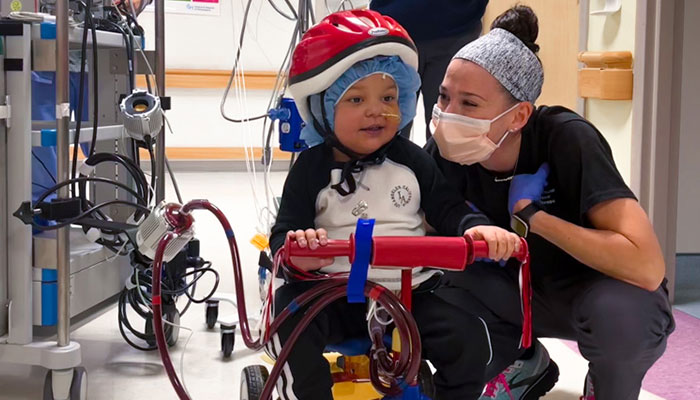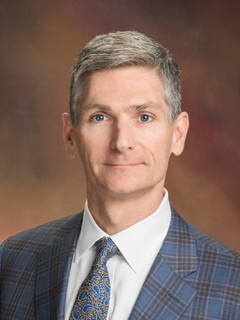HOW CAN WE HELP YOU? Call 1-800-TRY-CHOP
In This Section
Fueling the Heart: Frontier Program Seeks to Define and Treat Pediatric Heart Failure

Patient Ares Montanez participates in an intensive patient rehabilitation program at CHOP. The Advanced Cardiac Therapies Frontier Program is aiming to better understand the mechanisms of heart failure in children.
The human heart is nothing more than an intricate pump — taking in oxygen-depleted blood and pushing out oxygen-rich blood to the rest of the body.
Despite its name, heart "failure" doesn't mean the heart has stopped working altogether. Rather, the diagnosis refers to a problem in this circulatory process, which leads to chronic, progressive symptoms over time, according to Joseph Rossano, MD, chief of the Division of Cardiology at Children's Hospital of Philadelphia.
"It occurs when the heart fails to do its job pumping blood effectively," he said.
For adults, heart failure is most often the consequence of coronary artery disease, which happens when fatty deposits build up in the arteries, reduce blood flow, and can lead to a heart attack. Thanks to scientific progress over the past two decades, chronic heart failure can be treated with medical therapy.
But in children, the disease — and its prognosis — looks very different.
"By and large, heart failure in children is caused by a primary problem with the heart muscle, called a cardiomyopathy, or a consequence of having congenital heart disease that has undergone at least one surgery, sometimes many surgeries, and it is just not functioning well over time," Dr. Rossano said.
Currently, clinicians tend to "borrow" chronic health failure treatments that work for adults and try these approaches for children. However, children are not "small adults" (as the common refrain goes at CHOP), and the field of pediatric cardiology is suffering greatly from lack of research in this area, Dr. Rossano said.
"The likelihood of a child needing a heart transplant is much higher than what we would see in the adult population, the likelihood of death is much higher, and the morbidities are much greater," he added.
To address this knowledge gap, Dr. Rossano is leading a CHOP Frontier Program called Advanced Cardiac Therapies for Heart Failure Patients. The program, which translates visionary research into cutting-edge clinical care, will aim to better understand the mechanisms of heart failure in children to find better ways to care for this population.
Characterizing 'An Engine Out of Fuel'
In 1939, researchers George Herrmann and George Decherd described a failing heart as an "engine out of fuel." If that's true, scientists have hypothesized, then feeding the organ with proper nutrients could possibly prevent — or even reverse — heart failure's detrimental effects.
"I always say even if the heart has a preference for fatty acids, it has to beat no matter what," said Jonathan Edwards, MD, a pediatric cardiologist at CHOP. "It will pick up whatever it can to build an energy supply and keep beating."
While the theory that a failing heart is in an energy-starved state has remained for decades, until recently, scientists had no way to precisely characterize the energy components in a healthy heart, as well as the energetic compromise during heart failure.
Led by Zoltan Arany, MD, PhD, a professor of Medicine and director of the Cardiovascular Metabolism Program at Penn Medicine, and Danielle Murashige, MD, PhD, and co-authored by Dr. Edwards, a CHOP-Penn research team was the first to create a detailed picture of the nutrients the adult human heart uses in its healthy and failing states.
Published in Science, the researchers collected samples from blood pumping in and out of the heart of patients undergoing a treatment for atrial fibrillation, as well as blood from the leg of those same patients. The research team then sampled blood from patients experiencing heart failure. Using mass spectrometry tools, Dr. Arany, Dr. Edwards, and the team were able to quantify levels of metabolites in the blood samples, revealing which ones the heart consumes during pumping, and which ones become byproducts.
They found that the healthy heart relies heavily on fatty acids for fuel, and it releases large amounts of amino acids. One of the most revealing findings, Dr. Edwards said, is that failing hearts used more ketones than healthy ones. The body produces ketones when the liver breaks down fat for energy.
"I have an interest in proteostasis, which is the homeostasis or quality control for proteins," Dr. Edwards said. "There is evidence that proteostasis pathways are disrupted in heart failure. Therefore, the increase in amino acid release in heart failure might be the result of poor protein quality control."
Though the implications of the findings from the Science paper are still unclear, Dr. Edwards and Dr. Rossano said the study provides a proof-of-concept that the CHOP Frontier Program team can now translate to children.
"This is the right time, with the technologies available, to understand what is different about pediatric heart failure, and can we identify targets that can translate to therapies?" Dr. Edwards said.
Mechanical Pumps, Medications, and a Dedicated ICU
In particular, the research team will aim to use those same tools to better characterize and understand right ventricular failure (RVF) in children.
In adults, heart failure begins in the left ventricle, but in children with congenital heart disease, it is typically the right ventricle that is implicated. There are no proven therapies for curing children with RVF, and a heart transplant is typically only a short-term solution.
"We don't understand how that heart behaves when it fails," Dr. Rossano said. "What's happening at the molecular level — the RNA that is being upregulated or downregulated, the changing of the protein expression — we have almost no knowledge of that."
Deep molecular profiling of the failing right ventricle in children, compared with tissue samples from healthy hearts, will enable the research team to identify new therapeutic targets, and then to study therapies by working with animal models. First, the team will repurpose therapies for adult left ventricle failure. These include empagliflozin, a metabolic modulator that inhibits the sodium-glucose pump SGLT2, and omecamtiv, a direct activator of myosin — the principal heart contractile protein. If successful, the team will move forward to test the drugs in a clinical trial, while simultaneously investigating new medications.
The Frontier Program team also is finding better ways to support young children's hearts with ventricular assist devices, which are mechanical pumps that help the heart pump blood. These devices have been shown to be effective in older children with heart failure, and even in younger children, but more progress needs to be made in developing these devices for young children with congenital disease or defects.
"We're looking for better strategies to develop pumps for this group of children," Dr. Rossano said.
A final part of the Advanced Cardiac Therapies for Health Failure Frontier Program will be to expand the Heart Failure Intensive Care Unit, which CHOP soft launched in 2022. Having an ICU team — and, eventually, a separate physical unit — dedicated to treating heart failure patients will help to ensure that these patients are getting the specialized care they need.
"Other patients who are in the ICU after elective surgeries may not necessarily be there for a long time, and they might have a relatively simple recovery," Dr. Rossano said. "Unfortunately, that's not the case for children with heart failure.
"Their need for rehabilitation, their nutritional needs, are very different. We want to make sure that we can give them the best care so they can rapidly recover — not make sure just their heart is getting better, but their whole body. And so, we're very excited to have this new unit."
